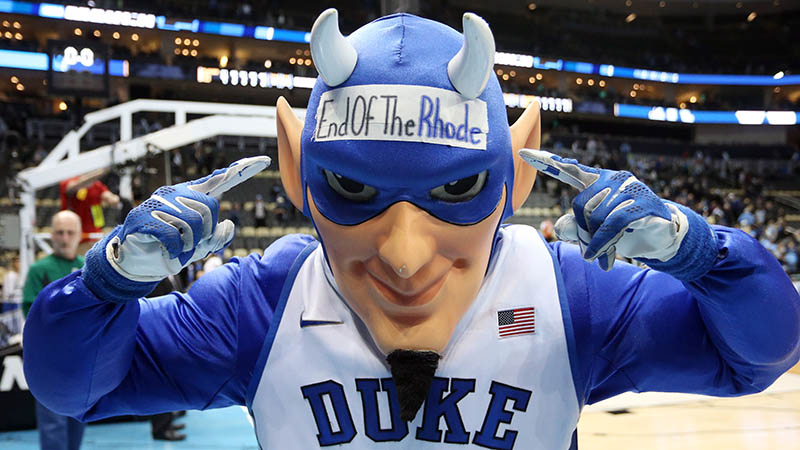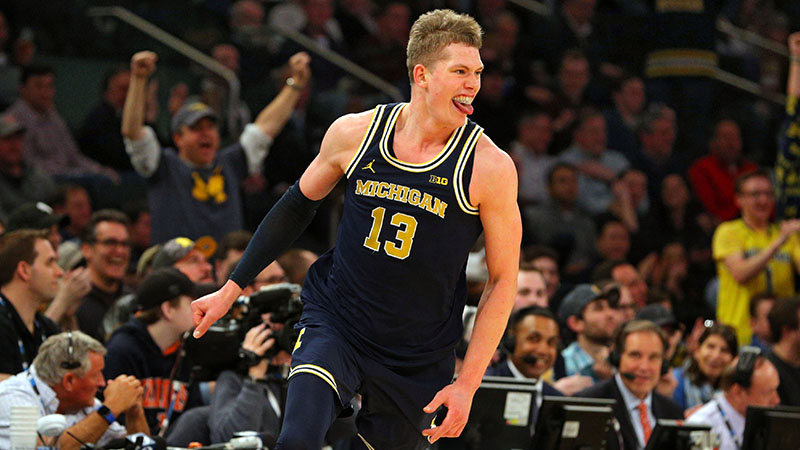The Story of Duke, the Inverted Middle, and a Different Way to Bet Tourney Props
Mar 17, 2018; Pittsburgh, PA, USA; The Duke Blue Devils mascot on the court after defeating the Rhode Island Rams in the second round of the 2018 NCAA Tournament at PPG Paints Arena. Mandatory Credit: Charles LeClaire-USA TODAY Sports
I had a great bet for everyone. And then I didn’t.
I had a great description, analysis, pricing. The works. But because I deal mostly with props and futures, the price changed, and all I have to bring you now is a good story.
As Brad Pitt (aka Rusty Ryan) once said in "Ocean’s Eleven": “In this town your luck can change just that quickly.”
As Brad Pitt never said in "Ocean’s Eleven," the good news is that this story has a happy ending for you. And we should start at the beginning.
The Initial Prop
One of the biggest winners of the first weekend of the NCAA Tournament was Duke. Sure, the Blue Devils defeated Iona and Rhode Island, but their biggest win came when Syracuse defeated Michigan State in a truly ugly game. That result means that the Blue Devils avoided one of their primary obstacles to winning a title in Michigan State.
The removal of Sparty from Duke’s path is now reflected in the futures market, where the Blue Devils have overtaken Villanova as the favorite to win it all. Duke is now +375 to win the title. In my opinion, Duke should be the favorite, so nothing really to report here. This price is correct.
However, one book was offering a prop in conjunction with this same type of analysis: Will an ACC team win the title? The prices on this prop (as of Tuesday morning): Yes +181 /No -211. There are 4 ACC teams remaining: Duke, Syracuse (which plays Duke in the Sweet 16), Florida State and Clemson.
The three non-Duke ACC teams have about a 0 percent chance to win the title. Clemson has the most talent of the trio, but the Tigers' path is going to most likely be Kansas-Duke-Villanova-Title Game Opponent X. They will be a significant dog in every game. Syracuse essentially has the same path and much less talent. The Orange managed to defeat Michigan State basically because the Spartans couldn’t figure out how to beat a zone defense. Florida State has an easier path (something like Gonzaga-Michigan-Kentucky-Title Game Opponent X), but the Seminoles will still be a dog in every game, and nothing about their performance this season says they have a chance (they defeated just three ranked teams in the entire regular season).
If it’s true that the likelihood of Clemson, Florida State or Syracuse winning the title is near zero, then there was value in playing both Duke AND the Field vs. the ACC, because of the difference in price (+375/-211). Although it isn’t true arbitrage because there’s risk, the value would've made it a profitable series of bets. This type of play is called an “inverted middle” or a “Polish middle.” In this particular example, you win if any of the following conditions is met:
- Duke wins the NCAA Tournament
- Any non-ACC team wins the NCAA Tournament (Villanova, Kansas, Purdue, Texas Tech, Michigan, Gonzaga, Kentucky, West Virginia, Nevada, Texas A&M, Kansas State, Loyola)
You lose if any of these conditions is met:
- Clemson, Florida State, or Syracuse wins the NCAA Tournament
You are essentially, in this case, creating a new bet, which is: Will Syracuse, Clemson or Florida State win the NCAA title? And you are betting no. What price are you getting on no? About -800 if you think of it as a singular bet. Because of what you are investing on both sides and what you are getting back, this bet returns about 12.49% of what you put in. Here’s an example of how you could bet it using a round number:
- $100 on Duke to win the title at +375 ($100 returns $475)
- $322.25 on Field vs ACC to win the title at -211 ($322.25 returns $475)
Now here are the financial implications, with that betting structure in mind:
- Duke wins title: +$52.75
- Non-ACC team wins title: +$52.75
- Syracuse, FSU or Clemson wins title: -$422.25
The Aftermath
And that was that. Math, analysis … incredibly funny jokes. I had it all.
And it’s a shame, really. You could have locked in a little profit more often than not. Or maybe dozens of people would beat you to it, and you’d be left with the price we have (as of Wednesday at noon ET), where instead of -211, the price is now -350 (and devoid of value).
That’s the lesson with playing props and futures. The markets are so small, a few thousand or even hundred dollars in the right situation, and poof, the price is gone. Even a small gust of wind can move a prop 10 cents.
But I said we had a happy ending to this story, and really that’s for two reasons. One is that the concept of Duke and the inverted middle can be applied to another prop as well.
But first, the real lesson here: betting props and futures isn’t always about what you think is really going to happen. You don’t always need to just pick the team you think will win the title, bet it, and cross your fingers. There are all kinds of ways to play these markets, and this just happens to be one of them (provided you get the price you want).
In that same prop market, here’s another set of prices to consider:
- Automatic bid team wins NCAA Tournament -142
- At-large team wins NCAA Tournament +124
This prop is less cut-and-dry than the previous one, but since I know you’re wondering which teams are left in each category, here they are:
- Automatic bid teams remaining: Kansas, Villanova, Michigan, Loyola, Kentucky, Gonzaga
- At-large bid teams remaining: Purdue, Duke, Texas Tech, West Virginia, Clemson, Nevada, Texas A&M, Kansas State, Florida State, Syracuse
You probably have all kinds of opinions on teams you like, based on analytics, or logic, or your alma mater. I am less interested in which specific team will win here, and more interested in how to create a group that I think can never lose.
And that is why I’d like Duke to switch sides.
If I get Duke to switch sides (by playing the Blue Devils to win the title, now at +380, in conjunction with “Automatic bid team wins” -142, for equal “to win” amounts) I think I’ve got something. I pay a heavy price, but I also think I almost never lose.
First off, I get the six favorites to win the title. The top six. I get them all. Duke, Villanova, Kansas, Gonzaga, Kentucky, Michigan. I also get the favorite to win all four regions right now.
Here’s where it gets even better. The three top choices on the “at-large” team list — Purdue, Texas Tech, and West Virginia — all play in the same region. So the number of truly dangerous teams I have to sweat when it gets to the Final Four is essentially one, or none (depending on how far Villanova goes in that same region). They are going to knock each other out, and there’s nothing anyone can do about it.
Now, the price I pay here isn’t nearly as heavy as prop #1 (I’m paying only -400 here), but my middle is much bigger. I need to fade a lot of teams winning the title (nine of them, actually). But how much risk is there, really, when I get every team I want on my side, and the top three choices on the other side knock each other out anyway?
If anything, this is yet another example of trying to think through these props using as many different philosophies as possible. This isn’t the only way to solve the problem, it’s just one of many ways. The inverted middle.
Unfortunately, they never said anything in "Ocean’s Eleven" about that either.
Top photo via Charles LeClaire-USA TODAY Sports
How would you rate this article?






